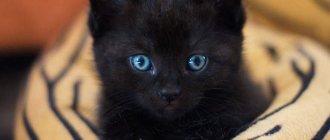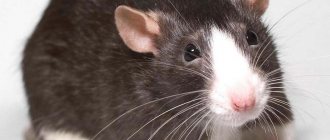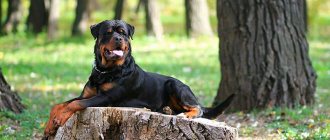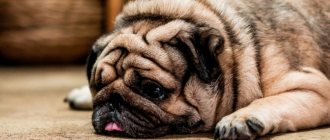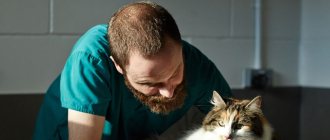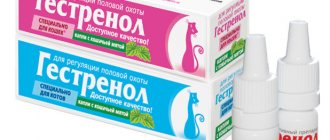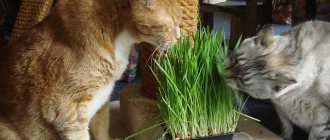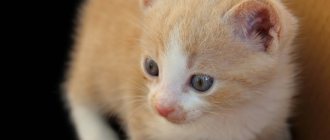To what age do cats grow, and when the animal’s skeleton is fully formed, it is important to know in order to properly care for it.
Studying the physiological characteristics of pets helps determine the timing of mating, explain the behavior of the animal and choose the optimal method of feeding. If you know at what age cats stop growing, this will allow you to decide which menu will be more suitable for the animal. A properly chosen diet will help you avoid various diseases associated with poor nutrition. Before the growth points are completely closed, the animal needs to be given more calories, calcium and magnesium. After growth stops, calories are reduced to prevent obesity, the development of diabetes and hormonal imbalances. Determining at what age the growth zones of skeletal bones close and domestic cats stop growing helps to provide complete care for your four-legged pet. Veterinarians believe that a cat of any breed acquires its permanent features at the age of 3 years, and a cat by 2 years.
The first week of life after the birth of a kitten is called the neonatal period.
Examples to what age cats can grow
When answering the question of how long cats grow, you should pay attention to the breed. Growth implies not only an increase in the external size of the cat, but also the formation of its internal organs and the entire body as a whole. The approximate total period for completing such a process, according to veterinarians, is 3 years for cats, 2 years for cats. Upon reaching this age, the appearance of animals, as a rule, does not change.
The timing of growth and development of cats is different for each breed.
Important! There is a variation in these terms depending on the breed of the pet. This is due to the fact that for each variety the process of formation of the endocrine system (pituitary gland) has different timing.
Regular
To what age do cats grow if they are ordinary? Domestic cats do not have set standards, as they are a mixture of different genotypes. They can grow as early as 1 year, while others, on the contrary, much later - only by 3 years.
"British"
Newborn kittens can weigh up to 140 g. By 9 months they grow very quickly and become sexually mature.
A British straight-eared cat at the age of 1 year weighs about 7 kg, and cats up to 5.5 kg. Then they continue to gain weight until 2.5-3 years and can reach a weight of up to 10-11 kg.
Note! Up to 2.5 years, the cat’s bones grow, and then the animal increases in width, building up muscles. General development ends by 3 years.
"British" can be raised up to 2.5 years
Sphinxes
Sphynx kittens are born tiny and helpless. Their birth weight is only 85 g. However, after 3 days they are able to feed on their mother’s milk on their own. Sphynxes are considered the smartest cats.
A Sphynx cat reaches puberty by 5–6 months. However, if the first mating takes place at this age, then the reproductive system stops working. Therefore, it is not recommended to mate a Sphynx before the age of 1 year. In general, their growth continues up to 2-2.5 years.
Sphynx growth ends after two years
Homemade
Domestic cats have their own developmental characteristics:
- the bulk is achieved by 2 years;
- much depends on heredity, nutrition and lifestyle;
- sedentary animals grow up to 9 kg.
How old do cats grow?
On average, cats grow up to 2-3 years of age, at this stage the accumulation of muscle mass ends.
How old do kittens grow?
Kittens usually grow until they are 1 year old, after which they enter adulthood.
Table by age and body weight
Let's look at the example of a British cat. This is one of the most popular breeds today. This is what an animal’s body weight should be depending on its age.
| Age | Cat | Cat |
| At birth | 60… 140 g | 70… 140 g |
| 1 month | 250… 600 g | 550… 740 g |
| 2 months | 450… 900 g | 1… 1.7 kg |
| 3 months | 1… 1.5 kg | 1.5… 2.5 kg |
| 4 months | 1.7…2.4 kg | 2.1… 3.9 kg |
| 5 months | 2.2… 2.9 kg | 2.6…4.3 kg |
| 6 months | 2.3… 3.6 kg | 3… 5.4 kg |
| 7 months | 2.4… 3.9 kg | 3.3…5.6 kg |
| 8 months | 2.5… 4.1 kg | 3.5… 6 kg |
| 9 months | 2.5… 4.3 kg | 3.8… 6.4 kg |
| 10 months | 2.5… 4.4 kg | 4.1… 6.7 kg |
| 11 months | 2.5… 4.5 kg | 4.3… 6.8 kg |
| 1 year | 2.5… 4.6 kg | 4.5… 7 kg |
From the figures in this table it is clear that the cat significantly exceeds the “beautiful half” in weight. But again, it all depends on the factors that were listed at the very beginning of the article.
Of course, if you notice a significant underweight or overweight of your pet, it is advisable to contact a veterinarian.
Normal indicators
The average growth period is 2–3 years and is divided into several stages, which are the same for all cats, regardless of gender and breed. The following stages of development can be distinguished:
- Neonatal (infancy) – this period is very short. Literally a few days. As a rule, newborn kittens lose a little weight during this time. This is considered normal and should not bother owners. A completely natural process for all newborns, including humans.
The neonatal period lasts literally a few days
- The period of breastfeeding (suction) lasts approximately 3.5 weeks. At this time, the baby is steadily gaining weight, growing and developing. It is very important to provide weaker babies with access to the breast. The fact is that larger brothers and sisters can repel smaller ones, and underfeeding will negatively affect the growth of babies. Therefore, it is important to ensure that all kittens receive their milk quota.
The suckling period lasts until the kittens are able to start eating on their own.
- The transition period is the least noticeable. Lasts only 6 weeks. The kitten does not grow as quickly and noticeably as during the suckling period, and many owners do not even pay attention to the degree of development of the pet. Around this age, many try to take a kitten to a new home, not suspecting that this is fraught with consequences.
- Juvenile (teenage) – has the longest time period. Lasts from 2 months to full maturity. During this time, changes in appearance are very noticeable. From six months the animal acquires the features of an adult. At the end of the period, cats stop growing altogether, and female cats grow by a maximum of 2–3 cm.
The juvenile period continues until the cat is fully grown.
Experts say that up to a year old cats grow in length and width, and after that - only in breadth, gaining weight and muscle mass characteristic of an adult.
Deviations
Deviations in the development of kittens often begin unnoticed. There are no questions at all regarding outbred pets. The owners attribute everything to genes: small mother, short-legged father, etc. It is very difficult to track growth retardation, except for obvious pathological signs. As for breeding animals, a thoughtful and attentive breeder should pay attention to the development process of the kitten.
Deviations in the growth of a kitten can be of different nature and depend on many reasons:
- Litter size. Lack of food slows down the baby's growth. In a family with a large number of kittens, problems begin even in fetal development. The cat is not rubber, therefore, the larger the litter, the smaller the kittens. After the birth of a large number of kittens, the larger and stronger ones occupy the milkiest nipples. They are located in the lumbar part of the cat, are larger, and produce more milk. Small kittens get nipples in the mother's thoracic region. There they are smaller, there is less accumulated milk in them, and its nutritional value is lower. Knowing this, the breeder tries to place small nipples next to large nipples, providing them with adequate nutrition.
The larger the litter, the higher the risk that the weakest kittens will be increasingly delayed in development.
- Endocrine problems. Very often, endocrine problems cause the development of kittens to slow down. These troubles arise against the background of poor nutrition of the mother. Monotonous and unbalanced food leads to a decrease in the quality of milk and a lack of important hormones supplied with breast milk. As a rule, it occurs when babies are weaned early.
- Vitamin deficiency. Occurs against the background of early weaning from the mother. Lack of vitamins and microelements due to poor nutrition leads to slower growth of kittens. Vitamin deficiency can cause rickets, a dangerous disease for children.
- Genetic abnormalities and congenital diseases. Occurs during intrauterine development. They persecute kittens of some artificially bred breeds.
We recommend reading: Dog Walking Law for 2022: prohibitions, fines, amendments
I observed the lag in the development of a kitten with my own eyes when my cats had to feed foundlings who were left orphans. One of them was very weak and simply could not get through to the nipple. I had to supplement him with a syringe. This cat remained much smaller in size than it was supposed to be. Although she is now an adult (she is three years old), she is the size of a teenage kitten.
Why does the growth of cats and cats stop earlier?
The growth of kittens is seriously affected by the presence of parasites. The fact is that waste products of worms cause intoxication of the body as a whole. Because of this, appetite decreases and activity deteriorates. This leads to slower growth. Treatment corrects the situation. It is extremely important to regularly carry out parasite prevention.
Hormonal imbalances also affect the growth of the animal. Early castration, which some veterinarians recommend to carry out almost in infancy, interrupts the production of important sex hormones that directly affect the growth of the animal. This is especially true for cats.
Early mating has a catastrophic effect on the growth of the animal. It can stop growth altogether and lead to infertility. Therefore, you should not rush to start breeding; you should carefully monitor unwanted contacts.
Why do cats take longer to grow than they should?
The cat's growth can last longer due to late sterilization. The later an animal is castrated, the larger it will grow.
Are there differences in growth rates between cats and female cats of different breeds?
The growth rate of kittens is affected by their breed. The larger the breed, the longer the kitten develops. For example, Maine Coon, Bengal, and servals grow up to 3 years. In these breeds, kittens are born much larger than others.
Maine Coon is one of the largest breeds; growth of cats lasts up to 3 years
However, they also have differences in gender. Females complete their development much earlier. The sexually mature period slows down growth. Cats stop growing at one year of age, while males develop until they are 3 years old. It is extremely undesirable to start mating animals that have not completed their development.
Female sphinxes may stop growing at 5–6 months, at the onset of puberty. Males of this breed continue to grow up to 2.5 years.
Factors influencing growth
There are various factors that influence the growth of pets.
Genetics
To what age do small, medium and large breed dogs grow?
It is quite rare for kittens to outgrow their parents in size. A big kitten for a small cat is very rare.
Gender of the animal
Cats are always bigger than cats.
Breed Features
To understand how old cats grow, it is necessary to consider the characteristics of the breed. This factor is the main one influencing the size of the animal.
Features of some breeds:
- Bengali Females grow up to 9 months, and males - up to 2 years;
- Maine Coon grows up to 2 years old, but becomes truly adult only at 3 years old;
- Scottish fold cats grow up to 2.5-3 years;
- Siberian cat - up to 1.5 years;
- sphinx - up to 2 years;
- bobtail - up to 2 years;
- outbred cats (domestic breeds), due to the fact that they belong to a mixed genotype, have different growth rates. Therefore, many stop growing as early as one year, while others can grow up to 3 years.
Presence of surgical interventions
Cats that are neutered later in life tend to be larger in size than cats that are not spayed and those that were spayed before the age of 1 year.
Past viral diseases
Important health factors include:
- the presence of parasites that cause poisoning of the body with toxins, help slow down the growth of the cat, as they suck out vitamins and nutrients;
- diseases of any nature (hereditary, infectious, somatic) negatively affect the development of certain organs of the animal;
- diseases of the endocrine system directly affect the development of the cat. Hormonal imbalances cause the pet to stop developing. Endocrine imbalance can also be caused by stress.
Lifestyle
The cat’s lifestyle includes factors such as:
- food quality. A deficiency of vitamins and vital substances helps to slow down growth processes and even stop them. Possible disproportionate development of the body;
- living conditions. Normal temperature conditions, normal lighting and compliance with the rules of hygiene and cleanliness of keeping the animal, high quality sleep and rest time stimulate the proper development of the cat;
- Lifestyle. Those animals that lead an active lifestyle grow much faster, their body is more proportional, and their weight meets the standards;
- mating age. By 8 months, male cats are considered mature.
Important! Early mating contributes to slower growth, sometimes even to cessation.
Lifestyle is an important factor in the growth and development of a pet
Causes of delayed development
Very often, owners of purring pets are forced to consult a specialist about slow growth. Every owner can face this problem. The size of a cat primarily depends on heredity and genes. But that's not all. In order for the genetic code that is responsible for the growth of a kitten to be fully realized, it is necessary to create favorable external conditions for it.
A kitten's development may slow down for the following reasons.
- The food does not meet the norms and requirements. Although the kitten may look well-fed and well-fed, its growth does not correspond to the norm. When he grows intensively, his body needs good nutrition, and it is important that the food he eats is of high quality in composition. The food that is present in the animal’s diet must contain vitamins, calcium, phosphorus, and protein. In this case, it is important to take into account both the breed and age of the kitten. Not only your appearance, but also the state of your immune system depends on proper nutrition.
- Various diseases. It is very important to ensure that the kitten does not contract various infectious diseases to which the baby is most susceptible during intensive growth. It is necessary to carry out the necessary vaccination and treatment in a timely manner. One of the main reasons why an animal stops growing is the appearance of helminthic infestations.
- Hormonal disbalance. In this case we are talking about castration, which applies to cats, and about sterilization, which cats undergo. Therefore, before you decide to take such a step and submit your pet to this procedure, be sure to consult with a specialist to make sure that this kind of intervention will not harm the animal.
This leads to the conclusion that if you suddenly notice that your pet is stunted, you need to:
- first of all, go to the doctor;
- diversify your diet;
- carry out parasite prevention according to the recommendations of a specialist.
Stages of growth
At what age can a cat become pregnant for the first time?
There are several phases of growth in pets. The active growth phase usually lasts until the end of maturation, approximately 10-15 months (depending on the breed). Large breeds (for example, Maine Coons, Bengals, Servals) grow up to 2 years, and smaller ones - up to 3 years.
Important! At each stage of growth, the cat must be provided with favorable development conditions by the owner so that there are no developmental delays or deviations.
From birth to 4 days
This is the very first period from the moment the animal is born to 4 days. The period is called neonatal. The period is characterized by weight loss in babies.
Second period
The period is called suction. It lasts 3-3.5 weeks. The main trends of this stage: weight gain, active growth.
Transition stage
A longer period of 4 to 6 weeks. The main trends of the stage: active growth of all organs.
Post-suction stage
The teenage period is calculated from 2 months until the end of the cat’s development, which depends on the breed. The peak period coincides with the age of 3-5 months. When the teenage stage ends, cats stop growing, and cats increase by a maximum of 2-3 cm.
Important! By the age of 1 year, cats grow in length and breadth. After a year, they only grow in width until they gain the weight characteristic of their breed.
Why is my pet growing slowly?
How to bathe a kitten: with what frequency and at what age
To understand how long kittens grow, you need to pay attention to their lifestyle. There are many different factors that cause animal growth to slow down.
There are many reasons for a cat's slow growth
Care and habitat
Living conditions are very important for the development of a pet. Outdoor cats suffer significantly in development due to lack of proper care. This happens due to vitamin deficiency and weakened immunity.
Hormonal imbalance
Hormonal imbalances can slow down the development of an animal, but after some time it can begin to grow rapidly again. This is especially true for castrated males.
Presence of parasites in the body
If a kitten has worms, this will inevitably lead to slower growth. Worm infestations are dangerous for any pet of any age. The animal may even die.
Taking hormonal medications
Hormonal drugs, despite the prevalence of their use, can have a negative effect on the animal, slowing down its growth and development.
Important! The drugs can have a negative effect on the hormonal levels of purebred cats.
Passive lifestyle
It is known that pets leading a passive lifestyle grow more slowly, and their body may be disproportionate in development.
If a cat moves little, its muscular system stops growing, circulatory processes are disrupted, and concomitant diseases arise, for example, diabetes.
Important! Early mating can negatively affect the development of the pet.
Past viral diseases
Often, lack of weight is a consequence of past illnesses. Infections can affect a kitten’s fragile body, leading to disturbances in the gastrointestinal tract and deterioration in the absorption of substances. Organs do not receive enough nutrients from the blood, growth slows down and weight gain also slows down.
How to choose a kitten that will grow large?
First, you need to find a breeder of large-breed animals with extensive experience and a convincing reputation in order to purchase a suitable kitten from him. The animal must:
- be a purebred representative of your breed, which would be confirmed by metrics;
- have good health and vaccinations according to age. Notes about this should be looked for in veterinary documents;
- be at least two months old. Experts believe that for full development, a kitten must feed on mother’s milk up to this age;
It is advisable to choose a male animal, ideally the largest in the litter. It is worth paying attention to parents. Not all large breeds grow large and heavy. Heredity in this matter is one of the determining factors.
When choosing a kitten, the future owner's eyes widen
Then everything is simple. You should take proper care of your pet and feed it well, not allow it to wander on its own, and also contact the clinic in a timely manner if your pet gets sick.
What to do if the cat continues to grow
There are also opposite cases, the cat continues to grow, despite the fact that it has already crossed all age limits.
In this case it is necessary:
- understand the reasons for this phenomenon;
- put the animal on a diet;
- limit your diet to high-carbohydrate foods;
- encourage the cat to lead an active lifestyle;
- consult a veterinarian.
In order for a pet to grow properly, it is necessary to create favorable conditions for it: feed it with balanced food containing vitamins; maintain a temperature of at least 20 °C; from time to time, give anthelmintic drugs and fight skin parasites. Only then will the pet feel great.
Selection of vitamins
A vitamin complex for a cat must be prescribed by a veterinarian. An excess of vitamins is just as dangerous as a deficiency. An adult cat's body requires a balanced content of vitamins and minerals to function properly.
- If the owner feeds the cat premium food, then the required amount of vitamins is already included in the composition; nothing needs to be added except a half dose of the anti-shedding agent.
- If a cat eats natural food or economy class food, it will need an additional vitamin source in the form of tablets.
- For adult cats, there is a general strengthening vitamin and mineral complex with biotin.
- If the cat is sterilized, suitable supplements are selected. There are also vitamins for pregnant and lactating cats. They support the mother’s body during pregnancy and lactation.
- For older cats, complexes are provided that slow down aging and speed up metabolism.
- Cats and cats constantly need protein, so to increase muscle mass, you can give food protein.
- You should always choose vitamin-mineral complexes with taurine - this is an essential amino acid on which almost the entire body of cats relies.
The growth and development of cats is a complex process. Owners must control it and promote the normal development of their pet.
